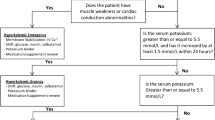Summary
The disposition of azapropazone 600 mg i.v. was investigated in 6 healthy subjects, 13 patients with cirrhosis and 8 patients with renal failure. In healthy subjects the elimination half-life was 12.2±2.1 h (mean ± SD), the volume of distribution 10.6±3.31 and the total clearance was 597±135 ml·h−1. Renal clearance accounted for about 62% of the total clearance. The free fraction of azapropazone in the plasma was 0.0045±0.0006. The patients with cirrhosis were divided into Group I with modest and Group II with severe impairment of liver function. In Group I the total clearance of azapropazone was not significantly different from that in healthy subjects. There was a 2.5-fold increase in its free fraction in plasma, and a reduction in the free drug clearance to about half that in healthy subjects. In Group II patients total clearance was reduced to about 20% of normal. This was partly due to reduced non-renal clearance but mainly to impaired renal clearance of azapropazone. The diminished renal clearance was considered at least in part to represent a drug-induced impairment of renal function, as there was a concomitant reduction in creatinine clearance. The free fraction of azapropazone in the plasma was markedly enhanced (>0.02), and simultaneously, free drug clearance was drastically reduced, to about 2% of that in healthy subjects. In patients with renal failure the total clearance was diminished, depending on the degree of impairment of kidney function. Anephric patients were estimated to have about one third of the total clearance in normal subjects. The free fraction of azapropazone in the plasma was increased in 4 of the 8 patients. It is concluded that patients with cirrhosis and modest impairment of liver function may require about half the normal dose of azapropazone, since free drug clearance is reduced by about 50%. Patients with severe impairment of liver function are expected to be highly susceptible to dose-related side effects, since the pronounced increase in the free fraction in plasma and the decreases in renal and non-renal clearance lead to marked reduction in free drug clearance and so to accumulation of free drug in the body. In patients with renal failure the dose of azapropazone should be reduced according to the degree of impairment of kidney function and plasma protein binding of the drug.
Similar content being viewed by others
References
Arisz L, Donker AJM, Brentjens JRH, Van der Hem GK (1976) The effect of indomethacin on proteinuria and kidney function in the nephrotic syndrome. Acta Med Scand 199: 121–125
Boyer TD, Zia P, Reynolds TB (1979) Effect of indomethacin and prostaglandin A1 on renal function and plasma renin activity in alcoholic liver disease. Gastroenterology 77: 215–222
Breuing KH, Gilfrich HJ, Meinertz T, Jähnchen E (1979) Pharmacokinetics of azapropazone following single oral and intravenous doses. Arzneim-Forsch (Drug Res) 29: 971–972
Brooks PM, Buchanan WW (1976) Azapropazone — its place in the management of rheumatoid conditions. Curr Med Res Opin 4: 94–100
Brooks PM, Mason DJR, McNeil K, Anderson JA, Buchanan WW (1976) An assessment of the therapeutic potential of azapropazone in rheumatoid arthritis. Curr Med Res Opin 4: 50–56.
Donker AJH, Arisz L, Brentjens JRH, Van der Hem GK, Hollemans HJG (1976) The effect of indomethacin on kidney function and plasma renin activity in man. Nephron 17: 288–295
Faust-Tinnefeld G, Geißler HE, Mutschler E (1977) Azapropazon-Plasmaspiegel unter rheumatologischer Kombinationstherapie mit D-Penicillamin und Immunsuppressiva. Arzneim-Forsch (Drug Res) 27: 2153–2157
Geißler HE, Mutschler E, Faust-Tinnefeld G (1977) Über die Bestimmung von Azapropazon aus Plasma durch direkte quantitative Dünnschichtchromatographie. Arzneim-Forsch (Drug Res) 27: 1713–1715
Gibaldi M, McNamara PJ (1978) Apparent volumes of distribution and drug binding to plasma proteins and tissues. Eur J Clin Pharmacol 13: 373–378
Gill JR, Frölich HC, Bowden RE, Taylor AA, Keiser HR, Seyberth HW, Oates JA, Bartter FC (1976) Bartter's syndrome. A disorder characterized by high urinary prostaglandins and a dependence of hyperreninemia on prostaglandin synthesis. Am J Med 61: 43–51
Gugler R, Shoeman DW, Huffman DH, Cohlmia JB, Azarnoff DL (1975) Pharmacokinetics of drugs in patients with the nephrotic syndrome. J Clin Invest 55: 1182–1189
Jähnchen E, Blanck KJ, Breuing KH, Gilfrich HJ, Meinertz T, Trenk D (1981) Plasma protein binding of azapropazone in patients with kidney and liver disease. Br J Clin Pharmacol 11: 361–367
Kimberly KP, Plotz PH (1977) Aspirin-induced depression of renal function. N Engl J Med 296: 418–423
Kimberly RP, Bowden RE, Keiser HR, Plotz PH (1978) Reduction of renal function by newer nonsteroidal anti-inflammatory drugs. Am J Med 64: 804–807
Levy G, Yacobi A (1974) Effect of plasma protein binding on elimination of warfarin. J Pharm Sci 63: 805–806
Metzler CM, Elfring GL, McEwen AJ (1974) A users manual for NONLIN and associated programs. Upjohn, Kalamazoo, MI
Mixich G (1972) Isolierung, Struktur und Synthese des Metaboliten von Azapropazondihydrat. Helv Chim Acta 55: 1031–1038
Mountokalakis TH, Karambasis TH (1977) Aspirin and renal function. Lancet 2: 88
Rau R (1977) Die nichtsteroidalen Antirheumatika in der Behandlung entzündlich-rheumatischer Erkrankungen. Therapiewoche 27: 2636–2644
Sausgruber H (1971) Klinischer Wirkungsnachweis der neuen Antiphlogisticums Azapropazon. Arzneim-Forsch (Drug Res) 21: 1230–1234
Schatz F, Adrian RW, Mixich G, Molnarova M, Reller J, Jahn U (1970) Pharmakokinetische Untersuchungen mit dem Antiphlogistikum Azapropazon (Prolixan 300) am Menschen. Therapiewoche 20: 2327–2333
Speckart P, Zia P, Zipser R (1977) The effect of sodium restriction and prostaglandin inhibition on the renin-angiotensin system in man. J Clin Endocrinol Metab 44: 832–837
Tan SY, Shapiro R, Kish MA (1979) Reversible acute renal failure induced by indomethacin. JAMA 241: 2732–2733
Thune S (1976) Long-term use of azapropazone in rheumatoid conditions. Curr Med Res Opin 4: 80–88
Zipser RD, Hofes JC, Speckart PF, Zia P, Horton R (1979) Prostaglandins: modulators of renal function and pressor resistance in chronic liver disease. J Clin Endocrinol Metab 48: 895–900
Author information
Authors and Affiliations
Rights and permissions
About this article
Cite this article
Breuing, K.H., Gilfrich, H.J., Meinertz, T. et al. Disposition of azapropazone in chronic renal and hepatic failure. Eur J Clin Pharmacol 20, 147–155 (1981). https://doi.org/10.1007/BF00607152
Received:
Accepted:
Issue Date:
DOI: https://doi.org/10.1007/BF00607152




